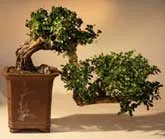All about your Fukien Tea

The fukien tea bonsai also goes by fujian tea and its scientific name of ehretia microphylla. They are named after the Fujian province of China where these trees are native to. Fukien tea love the heat and bright locations so keeping them as an indoor bonsai tree on an east or west facing windowsill can be quite easy. Additionally, Fukien tea work well as bonsai because they have naturally small leaves.
Caring for Fukien Tea (ehretia microphylla)
As with any tree, Fukien tea have their own lighting, watering, and temperature needs. The better these needs are met the healthier your bonsai tree will grow.
Lighting - If grown indoors fukien tea need to be in a bright area of about 1,000 lux. A typical brightly lit office is about 400 lux. By contrast outdoor sunlight will range between 32,000 and 100,000 lux. What that means is to do best your fukien tea needs to be in a brightly lit room preferably close to a window where it can get some indirect sunlight. I've had personal success keeping my fukien tea on a windowsill that had a west northwest exposure.
Watering - Like most bonsai trees, fukien tea like to be kept moist, but not soggy. Your ehretia microphylla will suffer if you let it soak or stand in water. Always use a fast draining bonsai soil for best results. You should never water your fukien tea bonsai by immersing the pot in water. If you keep your bonsai outdoors you should reduce watering slightly in the winter time.
Temperature - The fukien tea does not do well in extreme cold or areas with snow. Fukien tea bonsai can survive winters that go as low as 60 degrees fahrenheit and even occasional cold snaps of 40 degrees. Heat with this tree generally is not a concern if you keep it well watered.
Training Fukien Tea as Bonsai
Two of the most successful bonsai training styles for fukien tea are broom and literati. I've also seen some trained as cascade that were very nice. Wiring, although not necessary, can be done at any time of the year but the wire will start to cut into the tree after about three months. That is undesirable as it may leave scars in the trunk. Pruning the fukien tea into the shape you want is usually all that is necessary. As mentioned earlier, the leaves grow small naturally so leaf pruning and defoliation are not needed to produce smaller leaves for better perspective.
Special considerations for growing indoors
When growing fukien tea indoors some additional steps will help in keeping it healthy. First, it will help to supplement humidity. Next, make sure you are providing enough light. Last, be sure to inspect for bugs. The following paragraphs will explain these points more clearly.
To provide the necessary humidity around your fukien tea and to stop watering messes I'd recommend a humidity tray to go under your bonsai. Fill the tray with small pebbles or gravel, add water, and sit your bonsai pot on top of it. As the water evaporates it will provide humidity around the tree. There is some debate among bonsai enthusiasts as to the effectiveness of this, but I found that it works for me. At worst, it stops water draining from your pot all over your tables or counters.
As mentioned earlier, most rooms inside the typical home or office don't provide enough light by themselves to keep a fukien tea looking its best. Adding a bonsai grow light would help add additional lighting.
Last, pest insects that find their way onto your fukien tea will have no natural predators indoors unless you happen to keep ladybugs in your house. Visually inspecting your fukien tea regularly should help with bug outbreaks by allowing you to identify pests quickly and remove them before they become a problem. Fukien tea are susceptible to scale, mealy bugs, and aphids. Use a very weak pesticide because fukien tea are very sensitive to them. Never use diazinon on fukien tea.
